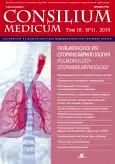Bronchial obstruction in children of preschool age
- Authors: Geppe N.A1, Kolosova N.G1
-
Affiliations:
- I.M.Sechenov First Moscow State Medical University of the Ministry of Health of the Russian Federation
- Issue: Vol 18, No 11 (2016)
- Pages: 25-29
- Section: Articles
- URL: https://journals.rcsi.science/2075-1753/article/view/94549
- ID: 94549
Cite item
Full Text
Abstract
Keywords
Full Text
##article.viewOnOriginalSite##About the authors
N. A Geppe
I.M.Sechenov First Moscow State Medical University of the Ministry of Health of the Russian Federation
Email: geppe@mma.ru
д-р мед. наук, проф., зав. каф. детских болезней ФГБОУ ВО Первый МГМУ им. И.М.Сеченова 119991, Russian Federation, Moscow, ul. Trubetskaia, d. 8, str. 2
N. G Kolosova
I.M.Sechenov First Moscow State Medical University of the Ministry of Health of the Russian Federation
Email: kolosovan@mail.ru
канд. мед. наук, доц. каф. детских болезней ФГБОУ ВО Первый МГМУ им. И.М.Сеченова 119991, Russian Federation, Moscow, ul. Trubetskaia, d. 8, str. 2
References
- Зайцева О.В. Бронхообструктивный синдром у детей. Педиатрия. 2005; 4: 94-104.
- Ducharme F.M, Tse S.M, Chauhan B. Diagnosis, management, and prognosis of preschool wheeze. Lancet 2014; 383 (9928): 1593-604.
- Cano-Garcinuño A, Mora-Gandarillas I; SLAM Study Group. Wheezing phenotypes in young children: an historical cohort study. Prim Care Respir J 2014; 23 (1): 60-6.
- Just J, Saint-Pierre P, Amat F et al. What lessons can be learned about asthma phenotypes in children from cohort studies? Pediatr Allergy Immunol 2015; 26 (4): 300-5.
- ERS Task Force, Brand P. Eur Respir J 2008; 32: 1096-110.
- Just J, Saint-Pierre P, Gouvis-Echraghi R et al. Wheeze phenotypes in young children have different courses during the preschool period. Ann Allergy Asthma Immunol 2013; 111 (4): 256-61.
- Raedler D, Ballenberger N, Klucker E et al. Identification of novel immune phenotypes for allergic and nonallergic childhood asthma. J Allergy Clin Immunol 2015; 135 (1): 81-91.
- Castro-Rodriguez J.A, Holberg C.J, Wright A.L, Martinez F.D. A clinical index to define risk of asthma in young children with recurrent wheezing. Am J Respir Crit Care Med 2000; 162: 1403-6.
- Bacharier L.B, Boner A, Carlsen K.H et al; European Pediatric Asthma Group. Diagnosis and treatment of asthma in childhood: a PRACTALL consensus report. Allergy 2008; 63 (1): 5-34.
- Papadopoulos N.G, Arakawa H, Carlsen K.H et al. International consensus on (ICON) pediatric asthma. Allergy 2012; 67 (8): 976-97.
- Global Initiative for Asthma (GINA). Pocket Guide for Asthma Management and Prevention in Children 5 Years and Younger, updated April 2015. Available from: http://www.ginasthma.org/local/uploads/files/GINA_PediatricPocket_2015.pdf.
- Национальная программа «Бронхиальная астма у детей. Стратегия лечения и профилактика». Изд. 4-е. М., 2012.
- Potter P.C. Current guidelines for the management of asthma in young children. Allergy Asthma Immunol Res 2010; 2 (1): 1-13.
- Durrani S, Guilbert T.W. Early treatment in preschool children: an evidence - based approach. Curr Opin Allergy Clin Immunol 2015; 15 (2): 175-83.
- Jackson D.J. Emerging issues in pediatric asthma: gaps in EPR-3 guidelines for infants and children. Curr Allergy Asthma Rep 2014; 14 (12): 477.
- Paul L.P et al. Eur Res J 2014; 43 (4): 1172-7. http://erj.ersjournals.com/content/43/4/1172.
- Guilbert T.W, Morgan W.J, Zeiger R.S et al. Long term inhaled corticosteroids in preschool children at high risk for asthma. N Eng J Med 2006; 354 (19): 1985-97.
- Castro-Rodriguez J.A, Rodrigo G.J. Efficacy of inhaled corticosteroids in infants and preschoolers with recurrent wheezing and asthma: a systematic review with meta - analysis. Pediatrics 2009; 123: e519-25.
- Camargo C.A, Ramachandran S, Ryskina K.L et al. Association between common asthma therapies and recurrent asthma exacerbations in children enrolled in a state Medicaid plan. Am J Health Syst Pharmacy 2007; 64: 1054-61.
- Boluyt N, Rottier B.L, de Jongste J.C et al. Assessment of controversial pediatric asthma management options using GRADE. Pediatrics 2012; 130: e658-e668. http://pediatrics.aappublications.org/content/130/3/e658?ijkey=31dccd4001bc31f79db1fa765e97dde9eb9f993d&keytype2=tf_ipsecsha
Supplementary files






